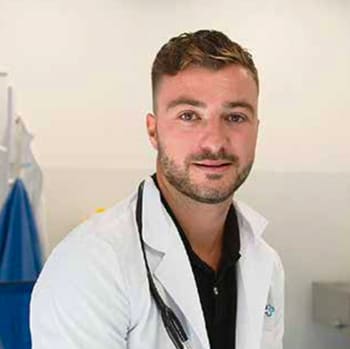
DOLOCATIL 1 g TABLETS
Ask a doctor about a prescription for DOLOCATIL 1 g TABLETS

How to use DOLOCATIL 1 g TABLETS
Introduction
Package Leaflet: Information for the User
Dolocatil1 gEFG Tablets
paracetamol
Read all of this leaflet carefully before you start taking this medicine because it contains important information for you.
- Keep this leaflet, you may need to read it again.
- If you have any further questions, ask your doctor or pharmacist.
- This medicine has been prescribed for you only. Do not pass it on to others. It may harm them, even if their symptoms are the same as yours.
- If you experience any side effects, talk to your doctor or pharmacist. This includes any possible side effects not listed in this leaflet. See section 4.
Contents of the package leaflet:
- What is Dolocatil and what is it used for
- What you need to know before you take Dolocatil
- How to take Dolocatil
- Possible side effects
- Storage of Dolocatil
- Contents of the pack and further information
1. What is Dolocatil and what is it used for
Dolocatil belongs to a group of medicines called analgesics and antipyretics.
It is used to treat the symptoms of pain and fever.
2. What you need to know before you take Dolocatil
Do nottake Dolocatil
- If you are allergic (hypersensitive) to paracetamol or any of the other ingredients of this medicine (listed in section 6).
Warnings and precautions
Do not take more than the recommended dose in section 3. How to take Dolocatil.
In patients with asthma who are sensitive to acetylsalicylic acid, you should consult your doctor before taking this medicine.
If you have any liver, kidney, heart, or lung disease, or if you have anemia (reduced hemoglobin levels in the blood, due to or not due to a reduction in red blood cells), you should consult your doctor before taking this medicine.
When you are being treated with any medicine for epilepsy, you should consult your doctor before taking this medicine, because when they are used at the same time, the efficacy of paracetamol is reduced and its hepatotoxicity is increased, especially in treatments with high doses of paracetamol.
In chronic alcoholics, you should be cautious not to take more than 2 g/24 hours of paracetamol.
If the pain persists for more than 5 days, the fever for more than 3 days, or if the pain or fever worsens or other symptoms appear, you should consult your doctor and re-evaluate the clinical situation.
In children under 15 years of age, consult your doctor or pharmacist, as there are other presentations with doses that are suitable for this group of patients.
During treatment with Dolocatil, inform your doctor immediately if:
- If you have severe diseases, such as severe renal failure or sepsis (when bacteria and their toxins circulate in the blood, causing damage to organs), or if you have malnutrition, chronic alcoholism, or if you are also taking flucloxacillin (an antibiotic). A severe disease called metabolic acidosis (an anomaly in the blood and fluids) has been reported in patients in these situations when paracetamol is used at regular doses for a prolonged period or when paracetamol is taken with flucloxacillin. The symptoms of metabolic acidosis may include: severe respiratory distress with deep and rapid breathing, drowsiness, feeling of discomfort (nausea) and vomiting.
Other medicines and Dolocatil:
Tell your doctor or pharmacist if you are using or have recently used any other medicines, including those obtained without a prescription.
Paracetamol may interact with the following medicines:
- Medicines to prevent blood clots: Oral anticoagulants (acenocoumarol, warfarin)
- Medicines to treat epilepsy: Antiepileptics (lamotrigine, phenytoin or other hydantoins, phenobarbital, methylphenobarbital, primidone, carbamazepine)
- Medicines to treat tuberculosis: (isoniazid, rifampicin)
- Medicines to treat depression and convulsions: Barbiturates (used as hypnotics, sedatives, and anticonvulsants)
- Medicines to lower cholesterol levels in the blood: (cholestyramine)
- Medicines used to increase urine elimination (loop diuretics such as furosemide)
- Medicines used to treat gout (probenecid and sulfinpyrazone)
- Medicines used to prevent nausea and vomiting: Metoclopramide and domperidone
- Medicines used to treat high blood pressure and heart rhythm disorders (arrhythmias): Propranolol.
- Flucloxacillin (antibiotic), due to a serious risk of blood and fluid anomaly (called metabolic acidosis) that requires urgent treatment (see section 2).
Do not use with other analgesics (pain-relieving medicines) without consulting your doctor.
As a general rule for any medicine, it is recommended to systematically inform your doctor or pharmacist if you are being treated with another medicine. In the case of treatment with oral anticoagulants, it can be administered occasionally as the analgesic of choice.
Interference with laboratory tests:
If you are going to have any laboratory tests (including blood tests, urine tests, skin tests that use allergens, etc.), inform your doctor that you are taking this medicine, as it may alter the results of these tests.
Taking Dolocatil with food, drinks, and alcohol
The use of paracetamol in patients who habitually consume alcohol (three or more alcoholic beverages per day: beer, wine, liquor... per day) may cause liver damage.
Taking this medicine with food does not affect its efficacy.
Pregnancy and breastfeeding:
If you are pregnant or breastfeeding, think you may be pregnant, or are planning to become pregnant, consult your doctor or pharmacist before using this medicine.
Taking medicines during pregnancy can be dangerous for the embryo or fetus and should be monitored by your doctor.
If necessary, Dolocatil can be used during pregnancy. You should use the lowest possible dose that reduces the pain or fever and use it for the shortest possible time. Contact your doctor if the pain or fever does not decrease or if you need to take the medicine more frequently.
Small amounts of paracetamol may appear in breast milk, so it is recommended that you consult your doctor or pharmacist before taking this medicine.
Driving and using machines:
The influence of paracetamol on the ability to drive and use machines is zero or insignificant.
3. How to take Dolocatil
Follow the instructions for administration of the medicine contained in this leaflet or as indicated by your doctor or pharmacist. If you are unsure, consult your doctor or pharmacist again.
Remember to take your medicine. Dolocatil should be taken orally.
According to your preferences, the tablets can be swallowed directly or broken in half, with the help of a glass of liquid, preferably water.
The score line is only for breaking and facilitating swallowing but not for dividing into equal doses.
Consult your doctor or pharmacist if you have any doubts.
The recommended dose is:
Adults and adolescents over 15 years: the usual dose is 1 tablet (1 g of paracetamol) 3 times a day. The doses should be spaced at least 4 hours apart. Do not take more than 4 tablets (4 g) in 24 hours.
Patient with liver disease: before taking this medicine, they must consult their doctor. They should take the amount of medicine prescribed by their doctor with a minimum interval between each dose of 8 hours. They should not take more than 2 grams of paracetamol in 24 hours, divided into 2 doses.
Patient with kidney disease: before taking this medicine, they must consult their doctor.
Take a maximum of 500 milligrams per dose.
Due to the dose, 1 gram of paracetamol, it is not indicated for this group of patients.
Elderly patients: should consult their doctor.
Use in children and adolescents
Do not use in children under 15 years of age.
If you think the action of the medicine is too strong or too weak, tell your doctor or pharmacist.
When lower doses of paracetamol are required per dose, other presentations of paracetamol that are suitable for the required dosage should be used.
If you take more Dolocatil than you should
You should consult your doctor or pharmacist immediately. In case of overdose or accidental ingestion, go immediately to a medical center or call the Toxicology Information Service (telephone 91 562 04 20), indicating the medicine and the amount taken.
If you have ingested an overdose, you should go immediately to a medical center, even if you do not notice symptoms, since they often do not appear until 3 days after ingestion of the overdose, even in cases of severe poisoning.
The symptoms of overdose may be: dizziness, vomiting, loss of appetite, yellowing of the skin and eyes (jaundice), abdominal pain, and pancreatitis (inflammation of the pancreas).
Treatment of overdose is most effective if started within 4 hours of taking the medicine.
Patient taking barbiturates or chronic alcoholics may be more susceptible to the toxicity of a paracetamol overdose.
If you forget to take Dolocatil
Do not take a double dose to make up for forgotten doses, simply take the forgotten dose when you remember, taking the next doses with the indicated interval between them (at least 4 hours).
4. Possible side effects
Like all medicines, this medicine can cause side effects, although not everybody gets them.
Rare side effects that may occur (may affect up to 1 in 1,000 people) are: discomfort, low blood pressure (hypotension), and increased levels of transaminases in the blood.
Very rare side effects that may occur (may affect up to 1 in 10,000 people) are: kidney disease, cloudy urine, allergic dermatitis (skin rash), jaundice (yellowing of the skin), blood disorders (agranulocytosis, leucopenia, neutropenia, hemolytic anemia), and low blood sugar (hypoglycemia). Very rare cases of severe skin reactions have been reported.
Paracetamol may damage the liver when taken in high doses or for prolonged periods.
Side effects of unknown frequency (cannot be estimated from the available data): a serious disease that can make the blood more acidic (called metabolic acidosis) in patients with severe disease who use paracetamol (see section 2).
Reporting of side effects
If you experience any side effects, talk to your doctor or pharmacist, even if they are not listed in this leaflet. You can also report them directly through the Spanish Medicines and Health Products Agency's website: https://www.notificaram.es. By reporting side effects, you can help provide more information on the safety of this medicine.
5. Storage of Dolocatil
Keep this medicine out of the sight and reach of children.
This medicine does not require any special storage conditions.
Do not use this medicine after the expiry date which is stated on the packaging (after EXP.). The expiry date is the last day of the month shown.
Medicines should not be disposed of via wastewater or household waste. Ask your pharmacist how to dispose of medicines no longer required. These measures will help protect the environment.
6. Contents of the pack and further information
Composition of Dolocatil
- The active ingredient is paracetamol.
- The other ingredients are: povidone, magnesium stearate, anhydrous colloidal silica, sodium starch glycolate (Type A) (potato origin) and pregelatinized starch (corn origin).
Appearance of Dolocatil and pack contents
Oblong tablets, white in color and scored, in packs of 20 and 40 tablets.
The tablets are scored, which allows them to be broken in half.
Marketing authorization holder
Ferrer Internacional, S.A.
Gran Vía Carlos III, 94
08028 - Barcelona
Manufacturer
Ferrer Internacional, S.A.
Joan XXIII, 10
08950 – Esplugues de Llobregat (Barcelona)
or
Ferrer Internacional, S.A.
Joan Buscallá, 1-9
08173 - Sant Cugat del Vallés (Barcelona)
Date of last revision of this leaflet: February 2025
Detailed and updated information on this medicine is available on the website of the Spanish Agency for Medicines and Health Products (AEMPS) http://www.aemps.gob.es/

How much does DOLOCATIL 1 g TABLETS cost in Spain ( 2025)?
The average price of DOLOCATIL 1 g TABLETS in November, 2025 is around 1.9 EUR. Prices may vary depending on the region, pharmacy, and whether a prescription is required. Always check with a local pharmacy or online source for the most accurate information.
- Country of registration
- Average pharmacy price1.9 EUR
- Active substance
- Prescription requiredYes
- Manufacturer
- This information is for reference only and does not constitute medical advice. Always consult a licensed doctor before taking any medication. Oladoctor is not responsible for medical decisions based on this content.
- Alternatives to DOLOCATIL 1 g TABLETSDosage form: TABLET, 1 gActive substance: paracetamolManufacturer: Uxa Farma S.A.Prescription requiredDosage form: TABLET, 1 gActive substance: paracetamolManufacturer: Laboratorios Cinfa S.A.Prescription not requiredDosage form: TABLET, 1 gActive substance: paracetamolManufacturer: Laboratorios Cinfa S.A.Prescription not required
Alternatives to DOLOCATIL 1 g TABLETS in other countries
The best alternatives with the same active ingredient and therapeutic effect.
Alternative to DOLOCATIL 1 g TABLETS in Poland
Alternative to DOLOCATIL 1 g TABLETS in Ukraine
Online doctors for DOLOCATIL 1 g TABLETS
Discuss dosage, side effects, interactions, contraindications, and prescription renewal for DOLOCATIL 1 g TABLETS – subject to medical assessment and local rules.















